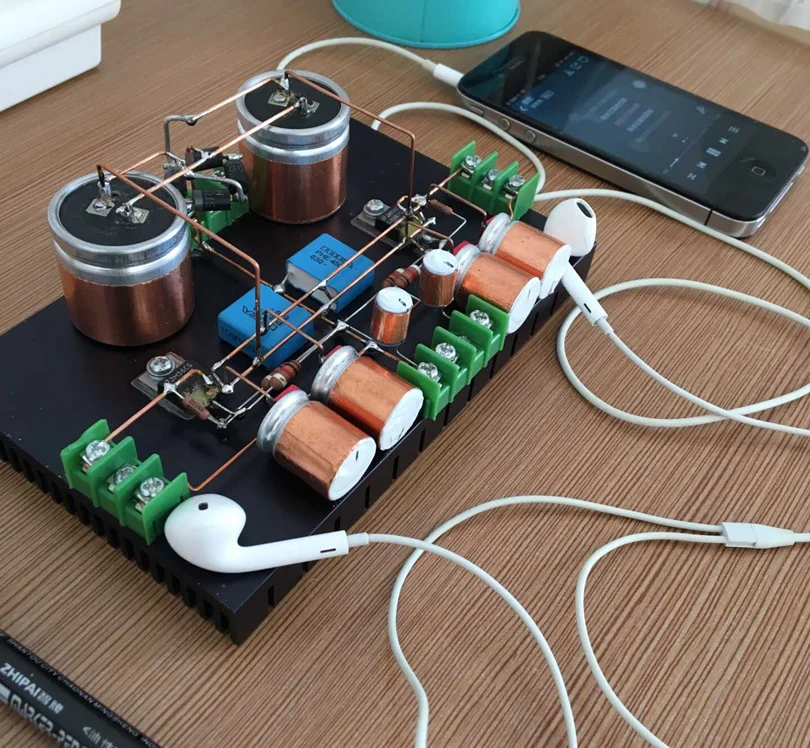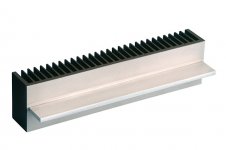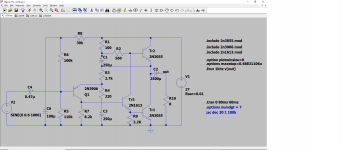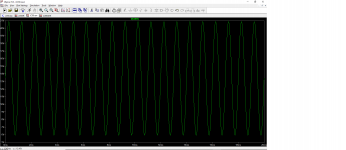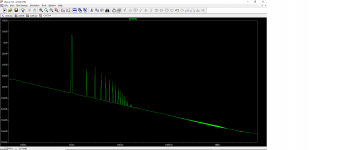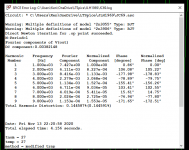@amplidude
do you mean to make TO-3 insulators from PCB material?
Normal FR4 has a high thermal resistance. Would not be a good idea- at least not in standard thickness (1.5/1.6mm). IMS substrates use something around 0.1mm thicknesses, which is not widely available as standalone PCB I think.
@olddiy - I don't think an intermediate alu bracket is necessarily a problem - if it is 6mm thick.
But not 3mm.
do you mean to make TO-3 insulators from PCB material?
Normal FR4 has a high thermal resistance. Would not be a good idea- at least not in standard thickness (1.5/1.6mm). IMS substrates use something around 0.1mm thicknesses, which is not widely available as standalone PCB I think.
@olddiy - I don't think an intermediate alu bracket is necessarily a problem - if it is 6mm thick.
But not 3mm.
If insulators are used that applies whether or not the devices are mounted on a bracket. A bracket will add thermal resistance, and it's not easy mounting TO-3 cans on a flat-based finned heatsink without a bracket, or a bar.
It is possible for an ally bar- rather than an L shaped bracket - to be welded into a slot on a flat-based heatsink. Not tried that but I'm assured by a metal construction guy who told me that the welding was possible (6mm bar on a 10mm thick heatsink base). That would give a shorter distance than an L bracket.
The best that can be done is to mount TO-3 devices directly on heatsinks and insulate the sinks. Makes testing a little more precarious in not touching them with things that could ground them. I guess you could mill a TO-3 size window in the fins where you needed a transistor if you wanted to use TO-3's on a flat based sink rather than an old style with channels.
It is possible for an ally bar- rather than an L shaped bracket - to be welded into a slot on a flat-based heatsink. Not tried that but I'm assured by a metal construction guy who told me that the welding was possible (6mm bar on a 10mm thick heatsink base). That would give a shorter distance than an L bracket.
The best that can be done is to mount TO-3 devices directly on heatsinks and insulate the sinks. Makes testing a little more precarious in not touching them with things that could ground them. I guess you could mill a TO-3 size window in the fins where you needed a transistor if you wanted to use TO-3's on a flat based sink rather than an old style with channels.
Last edited:
Yes I'm aware of that, but it's for the leach superamp with 16 to-3, if I use pcb the pins will be better fixed, I intend to do all wirring with solid copper wire, this way I can pull and bend without harming the transistors. I have seen to many leach amps with long poor cabeling.
I think that is a neat look! Reminds me of 1930's style power panels (not that I saw them first hand but archive pix).
I've often thought of wiring an amp up like that as a work of art to hang on the wall as well as playing music.
But I've used wires for TO-3 in the main until recently. I've not had thermal problems with thick ally L brackets and TO-3's connected directly to the PCB through the ally. Pins are just long enough. No messy wires and shortest distances to decoupling caps.
I've often thought of wiring an amp up like that as a work of art to hang on the wall as well as playing music.
But I've used wires for TO-3 in the main until recently. I've not had thermal problems with thick ally L brackets and TO-3's connected directly to the PCB through the ally. Pins are just long enough. No messy wires and shortest distances to decoupling caps.
Last edited:
For quality TO3-friendly heatsinks, take a look at the options in this Oz manufacturer's catalogue: Conrad Heatsinks - Products AKSA gave me this suggestion many years ago, since he hails from the same city and uses the products himself.
These are good quality, thick castings. Some are quite heavy but beware that freight charges can be as much as product cost for customers on the other side of the globe. Still, exchange rates are currently favourable and Conrad do export much of their product.
These are good quality, thick castings. Some are quite heavy but beware that freight charges can be as much as product cost for customers on the other side of the globe. Still, exchange rates are currently favourable and Conrad do export much of their product.
Attachments
I installed and got LTSpice running today with fair success. It went more smoothly than I was expecting.
What JLH LTSpice simulations do you have that you would be willing to share and post (and models)?
I have built the miniJLH with TIP41C, then TIP35C and another with 2SD1047. When the boards arrive I will be trying the JLH2003.
Some simulations would go nicely with the experiments/modifications. Things like distortion and stability would be nice to look at.
What JLH LTSpice simulations do you have that you would be willing to share and post (and models)?
I have built the miniJLH with TIP41C, then TIP35C and another with 2SD1047. When the boards arrive I will be trying the JLH2003.
Some simulations would go nicely with the experiments/modifications. Things like distortion and stability would be nice to look at.
I found a JLH .asc file on the internet and after a few adjustments I have basic Vout and THD simulation results. It is just a rough start to get going with LTSpice today. I will later update to match a real board I have.
Does anyone have an example of stability analysis with LTSpice?
Also, anyone have trusted models for:
TTC004, TTA004
KSA992, KSC1845
TIP41C
TIP35C
2SD1047
2SC5200
If not I will search manufacturer offerings and the web.
Does anyone have an example of stability analysis with LTSpice?
Also, anyone have trusted models for:
TTC004, TTA004
KSA992, KSC1845
TIP41C
TIP35C
2SD1047
2SC5200
If not I will search manufacturer offerings and the web.
Attachments
Those semis that are single-source from Toshiba, On semi etc should be fine to use now - otherwise see Bob Cordell's site, CordellAudio.com - Home, to download his models for audio transistors, assuming your parts are genuine spec. too. Models for TIP 41,35 etc. could be a lottery. There are many manufacturers of these generic parts and all will only partly match such models as you find on the web. ST Micros's models are probably best for their "TIP"series products which are widely available everywhere.
Use Toshiba's site to download 2SC5200, A1943 models, bearing in mind that different packages will have different thermal-related characteristics and TTC prefix variants are of Chinese production which from the the outset, were known to have smaller dies than standard Japanese products. Manufacturers such as Fairchild (now On-semi) also produce or produced a version of these under various ID numbers and they may or may not be based on the same technology.
Use Toshiba's site to download 2SC5200, A1943 models, bearing in mind that different packages will have different thermal-related characteristics and TTC prefix variants are of Chinese production which from the the outset, were known to have smaller dies than standard Japanese products. Manufacturers such as Fairchild (now On-semi) also produce or produced a version of these under various ID numbers and they may or may not be based on the same technology.
Ian - those heatsinks are ideal tfor TO-3. Also I suggest for plastic packages. If you mount plastic devices on a flat heatsink you need M3 tapped holes. I've never found M3 taps mechanically robust in aluminium. I've found it much more reliable to use screw + nut on the other side. So I suggest that type of sink is also ideal for plastic.
If you prefer to keep devices "flat mounted" industrially, devices are clamped using a metal bar or clamp over the top. For that option I'd probably use a flat alu bar, use countersunk M3 screws to bolt the devices down and then bolt the bar onto the heatsink, using what seems to work for me are M5 screws and threaded holes.
If you prefer to keep devices "flat mounted" industrially, devices are clamped using a metal bar or clamp over the top. For that option I'd probably use a flat alu bar, use countersunk M3 screws to bolt the devices down and then bolt the bar onto the heatsink, using what seems to work for me are M5 screws and threaded holes.
A BD139-10 or BD139-16 should work as well as a 2N1711, or better.
Has anyone with a 2N1711 able to plot its output characteristics?
From what I've seen of a BD139 they're pretty good. Measured Early voltage 500V, capacitances not to dissimilar to the 1711. Stability relies on slowish output transistors like epitaxial base devices (TIP41, 2N3055, TIP3055,MJ15003 etc). (A typical device with gain of 100. Early voltage may be lower on the higher gain type. The lowest gain group is not a suitable replacement for a 1711.)
Has anyone with a 2N1711 able to plot its output characteristics?
From what I've seen of a BD139 they're pretty good. Measured Early voltage 500V, capacitances not to dissimilar to the 1711. Stability relies on slowish output transistors like epitaxial base devices (TIP41, 2N3055, TIP3055,MJ15003 etc). (A typical device with gain of 100. Early voltage may be lower on the higher gain type. The lowest gain group is not a suitable replacement for a 1711.)
Two Ls back-to-back indeed form T, but at some cost: this forms yet another heat resistance plane between two surfaces thus reducing overall heat transfer.
Aluminium profiles have to be purchased in a shop for metal supplies. They have much better prices and more choices.
Even though not perfect, from the above mentioned reasons, this seems to be the best practical solution. I have found 3m long, 80X80mm L piece, 6mm thick that costs 36EUR with VAT included. Back-to-back configuration does not double the heat transfer but helps a lot to enhance an overall effect. Now, two surfaces cover 180mm of the back of the heat sink and increases the heat transfer. More important, a cross cection of heat transfer doubles as the thickness increases from 6 mm to 12 mm. Such configuration isn't just practical but also aesthetically pleasing.
In theory, welding could be the best solution but:
1. you have to grind oxidised surface to enable welding. Every aluminium surface has an oxide layer which has much higher melting point and prevents melting of the metal. This is even more critical for commercial heat sinks which are anodised and this means a lot ofoxide film.
2. welding aluminium is not a trivial task. TIG welding with reverse polarity should be used. Even then there is a danger that spatter can ruin the heat-exchange surface.
3.Even if welding has been done perfectly you will have to paint or anodize the heat sink to restore good look.
Aluminium profiles have to be purchased in a shop for metal supplies. They have much better prices and more choices.
Even though not perfect, from the above mentioned reasons, this seems to be the best practical solution. I have found 3m long, 80X80mm L piece, 6mm thick that costs 36EUR with VAT included. Back-to-back configuration does not double the heat transfer but helps a lot to enhance an overall effect. Now, two surfaces cover 180mm of the back of the heat sink and increases the heat transfer. More important, a cross cection of heat transfer doubles as the thickness increases from 6 mm to 12 mm. Such configuration isn't just practical but also aesthetically pleasing.
In theory, welding could be the best solution but:
1. you have to grind oxidised surface to enable welding. Every aluminium surface has an oxide layer which has much higher melting point and prevents melting of the metal. This is even more critical for commercial heat sinks which are anodised and this means a lot ofoxide film.
2. welding aluminium is not a trivial task. TIG welding with reverse polarity should be used. Even then there is a danger that spatter can ruin the heat-exchange surface.
3.Even if welding has been done perfectly you will have to paint or anodize the heat sink to restore good look.
Last edited:
- Home
- Amplifiers
- Solid State
- JLH 10 Watt class A amplifier
